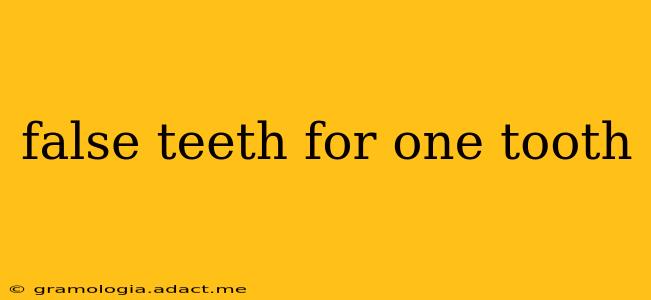Losing a single tooth can be a surprisingly significant event. It can impact your confidence, your ability to eat comfortably, and even the overall health of your mouth. Fortunately, there are several effective solutions available beyond simply living with the gap. This guide explores the various options for replacing a single missing tooth, helping you understand the best choice for your individual needs and budget.
What are my options for replacing one missing tooth?
This is often the first question people ask when facing tooth loss. The good news is that you have several choices, each with its own advantages and disadvantages. These include:
-
Dental Implants: Considered the gold standard for single-tooth replacement, dental implants are artificial tooth roots surgically placed into your jawbone. A crown is then attached, creating a permanent, natural-looking replacement tooth. Implants are incredibly durable and offer excellent functionality, but they are also the most expensive option.
-
Dental Bridges: A bridge involves attaching a replacement tooth (or teeth) to the adjacent teeth using crowns. This "bridges" the gap left by the missing tooth. Bridges are a more affordable alternative to implants but require the preparation of the neighboring teeth. They may also be less durable in the long run.
-
Partial Dentures: While often associated with multiple missing teeth, partial dentures can also be used to replace a single tooth. This is a removable appliance, which might be a less appealing option for some people. However, partial dentures are typically the most cost-effective solution.
Are there any non-surgical options for replacing a single tooth?
Yes, there are non-surgical options available, but their longevity and effectiveness may not be as long lasting or as natural looking as surgical options. Partial dentures, as mentioned above, are a non-surgical choice.
How long does it take to get a replacement tooth?
The timeline for getting a replacement tooth varies greatly depending on the chosen method:
-
Dental Implants: This process can take several months, including the initial surgery, healing period, and placement of the crown.
-
Dental Bridges: The timeline for dental bridges is generally shorter than for implants, often taking a few weeks to complete.
-
Partial Dentures: Partial dentures can often be fitted more quickly than implants or bridges, sometimes within a week or two.
How much does replacing a single tooth cost?
The cost of replacing a single tooth varies significantly depending on location, the chosen method, and the dentist's fees. Dental implants tend to be the most expensive option, while partial dentures are generally the most affordable. It's essential to consult with your dentist for a personalized cost estimate.
What are the long-term effects of not replacing a missing tooth?
Ignoring a missing tooth can have several negative consequences:
-
Shifting Teeth: The surrounding teeth can shift to fill the gap, affecting your bite and potentially causing misalignment.
-
Jawbone Loss: Without the stimulation of a tooth root, the jawbone can begin to deteriorate, leading to facial sagging and making future tooth replacement more challenging.
-
Difficulty Chewing and Speaking: A missing tooth can make chewing and speaking more difficult and uncomfortable.
-
Aesthetic Concerns: A gap in your smile can affect your confidence and self-esteem.
How do I choose the best option for me?
Choosing the right method for replacing a single missing tooth depends on various factors: your overall oral health, your budget, your lifestyle, and your aesthetic preferences. A consultation with a dentist or prosthodontist is crucial to assess your individual needs and discuss the most suitable treatment plan. They can help you weigh the pros and cons of each option and guide you towards the best solution for your unique situation. Don't hesitate to ask plenty of questions and ensure you understand the procedure completely before making a decision. Remember, restoring your smile is an investment in your overall health and well-being.
